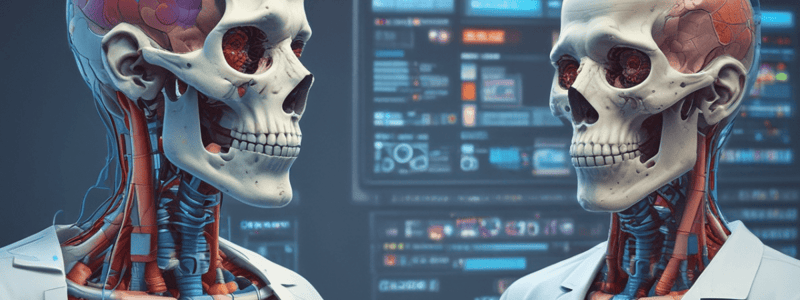Podcast
Questions and Answers
What distinguishes fifth-generation CT scanners from fourth-generation scanners?
What distinguishes fifth-generation CT scanners from fourth-generation scanners?
- The electron beam hits a fixed anode.
- The detector array rotates around the patient.
- The x-ray source becomes an integral part of the system design. (correct)
- The x-ray source rotates around the patient.
Which generation of CT scanners uses a rotating x-ray source inside a fixed detector array?
Which generation of CT scanners uses a rotating x-ray source inside a fixed detector array?
- Second generation
- Third generation
- Fifth generation
- Fourth generation (correct)
In fifth-generation CT scanners, what material is the anode made of?
In fifth-generation CT scanners, what material is the anode made of?
- Copper
- Aluminum
- Steel
- Tungsten (correct)
How do fourth-generation CT systems differ from third-generation systems?
How do fourth-generation CT systems differ from third-generation systems?
Which type of CT scanner produces collimated fan beam x-rays with no moving parts?
Which type of CT scanner produces collimated fan beam x-rays with no moving parts?
What was the significant advancement in the first-generation CT scanners?
What was the significant advancement in the first-generation CT scanners?
Which of the following statements accurately describes the evolution of CT scanners?
Which of the following statements accurately describes the evolution of CT scanners?
Who was the pioneer behind the development of the first CT scanner?
Who was the pioneer behind the development of the first CT scanner?
What was the initial application of the first CT scanner developed by Godfrey Hounsfield?
What was the initial application of the first CT scanner developed by Godfrey Hounsfield?
Which of the following statements accurately describes the detector arrangement in first-generation CT scanners?
Which of the following statements accurately describes the detector arrangement in first-generation CT scanners?
What was the primary advantage of the advancements in CT scanner technology over time?
What was the primary advantage of the advancements in CT scanner technology over time?
What was the primary limitation of first-generation CT scanners?
What was the primary limitation of first-generation CT scanners?
What was the key difference between first and second-generation CT scanners?
What was the key difference between first and second-generation CT scanners?
What was the primary advantage of using a fan beam in second-generation CT scanners?
What was the primary advantage of using a fan beam in second-generation CT scanners?
In first-generation CT scanners, how was the translation and rotation motion achieved?
In first-generation CT scanners, how was the translation and rotation motion achieved?
What was the purpose of the highly collimated beam in first-generation CT scanners?
What was the purpose of the highly collimated beam in first-generation CT scanners?
What was the approximate scan time for a single slice in second-generation CT scanners?
What was the approximate scan time for a single slice in second-generation CT scanners?
Flashcards are hidden until you start studying




